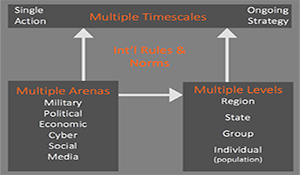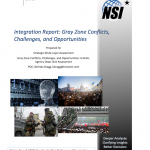Gray Zone Conflicts, Challenges, and Opportunities

Integration Report: Gray Zone Conflicts, Challenges, and Opportunities.
Author | Editor: Bragg, B. (NSI, Inc.).
Executive Summary
United States Special Operations Command (USSOCOM) requested a Strategic Multilayer Assessment effort “to determine how the USG can identify, diagnose, and assess indirect strategies, and develop response options against associated types of gray zone conflicts.” This integration report provides a synthesis of all the team projects. Their work has advanced understanding of the contours of the gray zone terrain, and the challenges inherent in navigating that terrain. By identifying the critical features of the gray zone, their findings also provide a guide to where USSOCOM and other DoD entities should focus future efforts in this area to facilitate the development of operational level planning and response strategies. The key results of the effort fall into four areas as summarized below.
What is the nature of gray zone conflict?
- There is no single condition that can identify an action as gray, independent of actor or understanding of the broader strategic context
- We need to think on multiple timescales, across multiple arenas (e.g. political, social, economic), and understand and engage with multiple social levels (state, group, individual)
- Populations are the key dimension in gray zone conflict
- Norm violations help define the threshold between ordinary competition and the gray zone
What motivates actors to engage in gray zone activities?
- Successful US deterrence has not eliminated the motivations of other actors to further their own interests
- Acting in the gray zone is an effective low risk, low cost strategy that has proven difficult for the US and partner nations to counter, and for vulnerable states to defend against
- US military places primacy on physical maneuver, and our adversaries know this
How should the US respond to gray zone activities?
- Incorporate the human / cognitive domain
- Think and plan beyond kinetic responses alone; expand DoD definitions of maneuver and objective to account for the human aspects of military operations
- Shape the international environment to reduce the motivations for engaging in gray zone activities
- Develop a clear, compelling strategic narratives
- Provide alternative narratives and leverage social and mass media to communicate them
- Build trust and credibility with partner nations to enable unity of effort
- An enduring, proactive presence and consistent messaging across all USG agencies is a significantly superior approach to taking select actions in response to specific gray actions
- Scope and timing of US response matters
- Inaction in the face of low level actions (e.g. Chinese Island building in the SCS) can over time create a “new reality” that threatens US interests and security
- Early and effective response to gray actions and strategies requires a consistent US presence
- Focus now should be less on defining specific actions as gray zone threats, and more on how to leverage all instruments of national power to respond to them
What capabilities does the US need to respond effectively to gray zone activities?
- Human/Cognitive Domain Information & Expertise
- Gray zone strategies exploit multiple instruments of power. Operating in this environment requires information across all of these instruments
- Conceptual Models and Frameworks
- Scope of gray zone activities will make information requirements overwhelming without models to guide search and interpretation

Comments